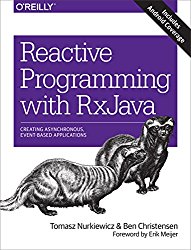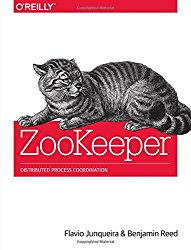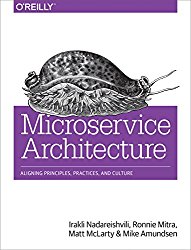Recent Content

RxJava is an implementation of “Reactive Extensions” (Rx) in Java. But what is
this? Originally Rx are an implementation of Microsoft to address the
increasing complexity of software. It is a model to build large scale
asynchronous service architectures.
Another company that has to be mentioned is Netflix: they implemented the
Rx in Java which resulted in RxJava.
On the programming side Rx looks very similar to how streams
(java.util.stream.Stream) work. The main difference in my opinion is that
streams are pull and lazy. They produce only as much data as someone is reading
from them. RxJava on the other side is more push style. The source of data is
pushing events through a pipe of operators similar to what you know from streams
(filter(), map(), and so on) to the sink. And as I know from this book, Java
streams are the wrong tool to parallelize anything that is not CPU bound–like
network requests. There reason for this is, that (parallel) streams are executed
on a thread pool that is shared with several other features of Java. This thread
pools is limited to have only that many workers as the system has CPU
cores. Therefore this pool gets exhausted very soon, when threads in it get
blocked by I/O operations. Any thread waiting for an I/O operation effectively
results in a processor core not used by your program.
RxJava on the other hand is not limited to a fixed thread pool. Any source
(Observable) and sink (Subscriber) of data can be bound declaratively to
user defined Schedulers. As well as Rx favours a model in which I/O
operations are done asynchronously and non-blocking. Therefore resulting in a
need for much fewer threads. In a traditional model of using one thread per
network connection, threads become very soon the first thing that limits
scalability.
What is really great about this book
The best part of this book for me were the reflections on Relational Database
Access in chapter 5. While as a developer you might be tempted to convert
everything to the reactive model, this part of the book shows where it doesn't
make sense to do so.
By converting the access to your relational database to an asynchronous model
you won't gain anything. Whatever you are doing on the client side, let's say
for example your PostgreSQL will run all of your concurrent requests in
different processes. This results in a noticeable limit on the number of
parallel queries you're able to run. You cannot lift this limit by becoming
asynchronous on the client side.
Links to the book

ZooKeeper is a component that facilitates building distributed applications.
It is:
- a distributed hierarchical key value store,
- chooses C(onsistency) and A(availability) in the CAP theorem,
- works best on read-dominated workloads (< 10% writes),
- keeps content in the memory of each instance, and
- expects the data stored on each node (key) to be small (maybe several KiB).
The data managed by ZooKeeper is presented in a file system like manner with
directories and files whose names get separated by slashes (/). The difference
to a file system is, that you can store information in the directories as well.
Or seen differently: directories are files at the same time. Based on this
simple abstraction, users of ZooKeeper can implement things like leader election
in a cluster of software instances.
weiterlesen | read more | lee mas | lê mais | 閱讀更多 »

To stay on the right track with microservices, I wanted to revisit the
philosophy and organizational recomendations on how to do them right. After
reading Building Microservices in april this year, I
got Microservice Architecture, aligning principles, practices, and culture by
Irakli Nadareishvili et al.; O'Reilly Media, Inc., 2016.
The book can be read on one week-end as the content is very well condensed to
118 pages.
weiterlesen | read more | lee mas | lê mais | 閱讀更多 »

It's hard to find sources how to do front-end micro-services in a single page
application (SPA). Having a single front-end that faces the user
makes it hard to impossible to exploid the full power of going micro-services in
the back-end. For every new function you cannot just deploy the corresponding
service, but you have the dependency to update and redeploy the service as well.
So I was looking around how to go micro in an SPA. One of the ideas
I found on the web was to do so using web components. To evaluate this idea as
someone working mainly on the backend I thought I should get some literature and
bought the book Developing Web Components by Jarrod Overson and Jason Strimpel,
O'Reilly Media, Inc., 2015.
weiterlesen | read more | lee mas | lê mais | 閱讀更多 »

Meine letzten IPv6-Tunnel werden langsam überflüssig. Seit letzter Woche haben
wir auch im Büro natives IPv6. Die Telekom hat uns auf einen NGN-Anschluss
umgestellt.
Setup
- Zugang zum Internet über VDSL der Telekom mit statischer IP
- Speedport als VDSL-Modem
- Linux-Box mit Debian terminiert PPPoE und verteilt es an zwei Subnetze
IPv6 aktivieren
Kurz zusammengefasst
Für den IPv6-Zugang muss der pppd IPv6 auf der PPP-Verbindung aktivieren. Die
Telekom benutzt dann Router-Advertisements (radv) um dem ppp0-Device eine
IPv6-Adresse zu geben. Soll IPv6 im LAN weiterverteilt werden, bekommen wir
Präfixe hierfür über Präfix-Delegation per DHCPv6. Letzteres kann aber nicht als
Ersatz für die Router-Advertisements genutzt werden, da die Telekom nur
Präfixdelegation darüber macht.
weiterlesen | read more | lee mas | lê mais | 閱讀更多 »
Mein einer Vorsatz für dieses Jahr ist es die Philosophie von Clojure zu denken.
Seit 2011 spiele ich mit Lisp und 2014 hatte ich meinen ersten Kontakt zu
Clojure, einem der Dialekte von Lisp. Der andere ist, ich möchte meine
Erfahrungen mit
Softwaretests
ausbauen. Bisher hatte ich vor allem an meinen Fähigkeiten mit Unit-Tests
gearbeitet und hierfür meinen Stil gefunden. Jetzt will ich automatische
Integrationstests in mein Standardrepertoire von Entwicklungstechniken
aufnehmen.
weiterlesen | read more | lee mas | lê mais | 閱讀更多 »
In welchem Editor kann ich den besten Code schreiben?
Vim wie bisher, doch vielleicht besser
Emacs oder gar wie meine Kollegen mit
einer IDE? Die letzten Wochen habe ich getestet: zwei Wochen nur Emacs und zwei
Wochen nur IntelliJ als IDE
weiterlesen | read more | lee mas | lê mais | 閱讀更多 »
Testgetriebene Entwicklung (TDD) funktioniert – überall. Sie scheitert nicht am
Kunden, den nicht Qualität sondern Tempo interessiert. Sie steht nicht im
Widerspruch zum jungen Projekt mit wenig Budget, das schnell Kunden gewinnen
muss um zu überleben. Sie hindert nicht daran schnell Features umsetzen zu
können. Ja, sie macht mir auch nicht (mehr) langsamer.
Es ist keine neun Monate her, dass ich das nicht glauben konnte. Mehrere Anläufe
hatte ich unternommen neben Code auch Tests zu schreiben. Länger als zwei
Monate ging das nie gut:
- Ich fühlte mich produktiver, wenn ich „richtigen“ Code statt Tests schrieb.
- Ich arbeitete in einem Team, das kein Interesse daran hatte Tests einzuführen.
- Es war nicht wichtig fehlerfrei zu arbeiten, die schnelle Umsetzung von neuen
Features war was zählte.
- Auch ohne Tests konnte ich relativ fehlerfrei entwickeln.
- Manchmal versuchten wir den Kunden zu überzeugen mit Tests zu entwickeln, aber
dieser hatte kein Interesse daran.
- Die Software an der ich gearbeitet habe war nicht besonders gut geeignet
testgetrieben entwickelt zu werden. Die Tests funktionierten solange gut wie
sie mit den knappen Beispiele aus Büchern gemacht wurden, aber unsere reale
Software war zu komplex dafür.
weiterlesen | read more | lee mas | lê mais | 閱讀更多 »
Tatort es una palabra alemana que significa «lugar del crimen». Pero para un
alemán en primer lugar es el nombre de una serie de películas policíacas que se
emiten cada domingo a las ocho y cuarto en la televisión pública. Esta serie se
emite desde 1970.
Su particularidad de esta telenovela es que no solo tiene un protagonista. La
serie tiene lugar en 20 ciudades de Alemania, Austria y Suiza. Cada ciudad tiene
un protagonista y también lo que ocurre en los episodios rodados en cada ciudad
es muy diferente. En todos ellos se puede apreciar las peculiaridades de cada
región. Algunos episodios tratan temas muy serios y otros son cómicos.
Esta serie es vista especialmente por la gente con un nivel de sociedad muy bien
educada. Cuando llegaba a la universidad hablábamos cada lunes sobre el último
capitulo de la serie.
Desde 1990 algunos episodios de Tatort tienen el nombre de «Polizeiruf 110».
Porque ese fue el nombre que se le dío en la República Democrática Alemana.
Además Alemania se reunificó en este año y se utilizan los dos nombres desde
entonces.
Aquí en Múnich hay varios medios de transporte público: el autobús y el autobús
articulado, el tranvía, el metro y el tren metropolitano. La diferencia entre
estos medios es el aforo y si necesiten caminos especiales.
Desde el año pasado tenemos una variación nuevo: el autobús con tráiler. Tiene
un aforo más grande que el autobús articulado. Pueden entrar unos 133 pasajeros
(en comparación: tranvía 220, autobús articulado 100).
Es un renacimiento: hace 60 años hubo autobuses con tráiler en Múnich también.
El último martes vi este vehículo por primera vez. Aquí una foto.








